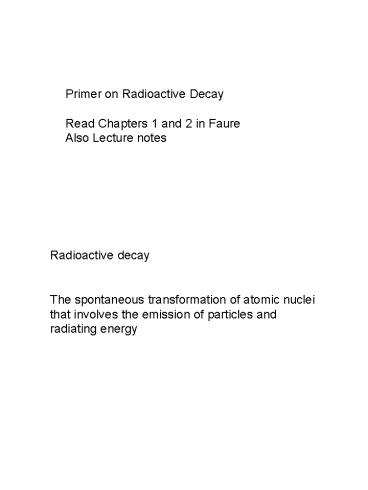Radioactive decay - PowerPoint PPT Presentation
1 / 14
Title:
Radioactive decay
Description:
Radioactive decay. The spontaneous transformation of atomic nuclei that involves ... Assumption 1: when the clock starts ticking, all sub-systems have the same ... – PowerPoint PPT presentation
Number of Views:498
Avg rating:3.0/5.0
Title: Radioactive decay
1
Primer on Radioactive Decay Read Chapters 1 and
2 in Faure Also Lecture notes
Radioactive decay The spontaneous
transformation of atomic nuclei that involves the
emission of particles and radiating energy
2
Various decay modes
Negative beta decay n p e- v E Positron
decay p n e v E Alpha decay AZX
A-4Z-2X 42He E Electron capture p e- n
E Fission decay (break down to subequal atoms)
3
A nucleus decays because it is unstable It may
be energetically favorable for a nucleus to break
apart into smaller constituents Why?
4
The concept of Binding Energy
Can we calculate the mass of an atom by adding
together the masses of the subatomic particles?
Mproton 1.00782503 amu Mneutron 1.00866491
amu
Lets take 56Fe, which has 26 protons and 30
neutrons
26 x 1.00782503 30 x 1.00866491 56.4633981
amu protons neutrons
However, the true mass of 56Fe is 55.934942 This
is less than the mass obtained by adding protons
and neutrons. There is thus a mass defect.
?m 0.52846 amu
5
A mass defect corresponds to a release in
energy. Mass is equivalent to Energy E
Mc2 Where C is the speed of light (3.00 x 108
m/s) 1 amu 931.5 MeV Thus, the above mass
defect corresponds to a binding energy
of 492.26 MeV Fusion of protons and neutrons
into 56Fe actually releases energy because 56Fe
is energetically more favorable. If we divide by
the number of nucleons (56), we find that the
binding energy per nucleon for 56Fe is 8.79
MeV / nucleon
6
Fe has the highest binding energy We will
explore why later. But what this means is that
Fe is one of the most stable nuclides
7
You can use these mass defects to see whether
certain decays are energetically favorable
(energetically favorable, however, does not
necessarily imply that it will happen any time
soon!) For example, as an exercise, consider
the negatron decay of 187Re to 187Os. Show that
this decay is energetically favorable (the mass
of the electron is negligible) By showing that
this decay is favorable, you are also showing
that the reverse is not favorable, that is, 187Os
will not positron decay to 187Re.
8
VALLEY OF STABILITY
9
MORE DETAILS LATER (JUST PRIMING YOU UP RIGHT
NOW)
10
- Relative probability of decay
- dN/dt - ?N
- decay constant s-1
- N Noe-?t
- What is the half-life?
11
A geologically more useful form D N (e?t 1)
1 eqn, 1 unknown, D and N are measured
N
No D N
D
12
But what if there was an initial amount of
daughter product, e.g. Do
D Do N (e?t 1)
1 eqn, two unknowns (Do and t)
We thus need at least one more equation e.g.,
two hourglasses
13
ISOCHRON DATING
m e?t - 1
D
Do
N
Assumption 1 when the clock starts ticking, all
sub-systems have the same starting point, that
is, the same amount of daughter product
Do Assumption 2 decay rate is
constant Assumption 3 sub-systems do not
interact with each other, e.g., no mass exchange
between them
14
MORE STUFF ON THE WHITEBOARD































